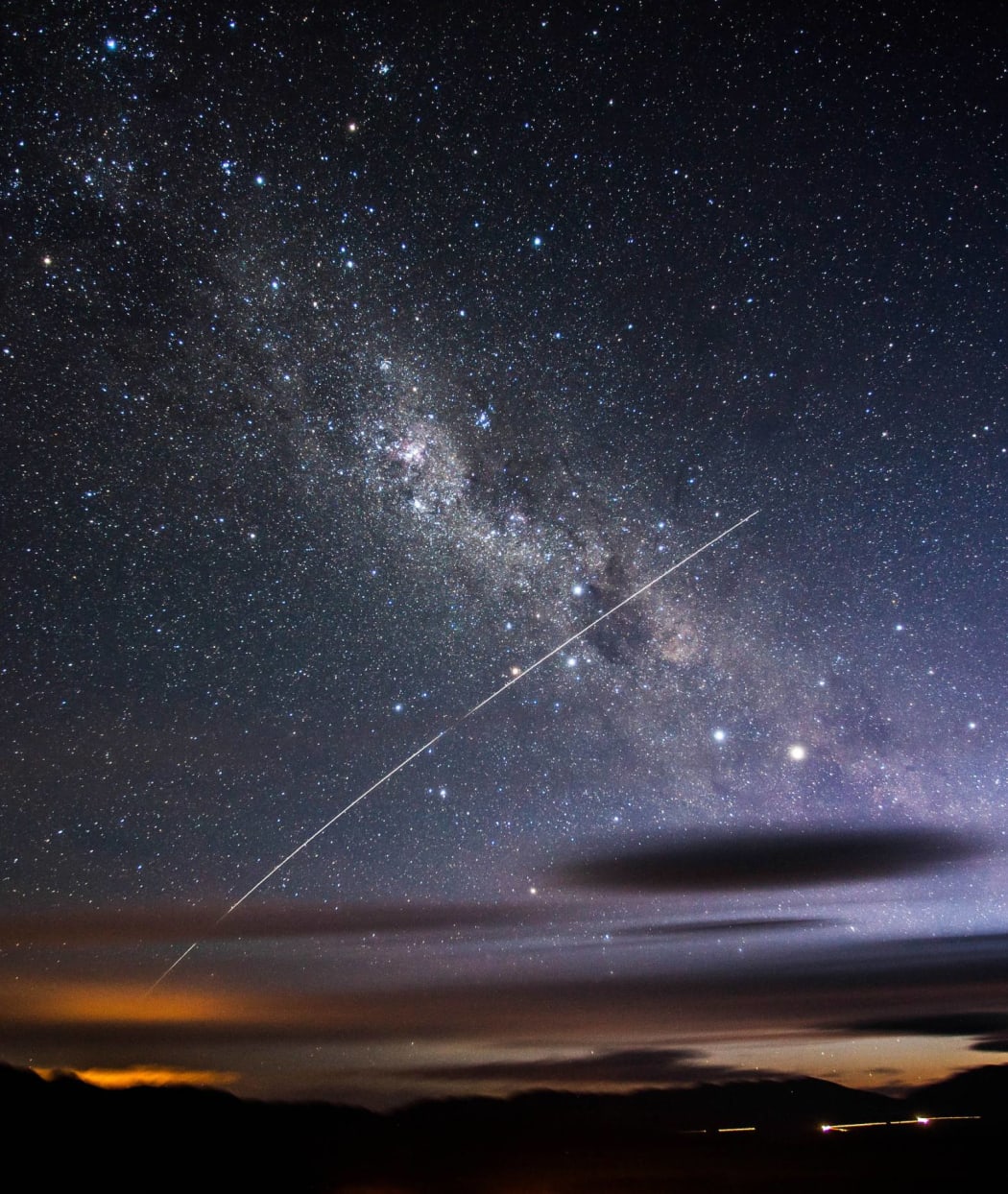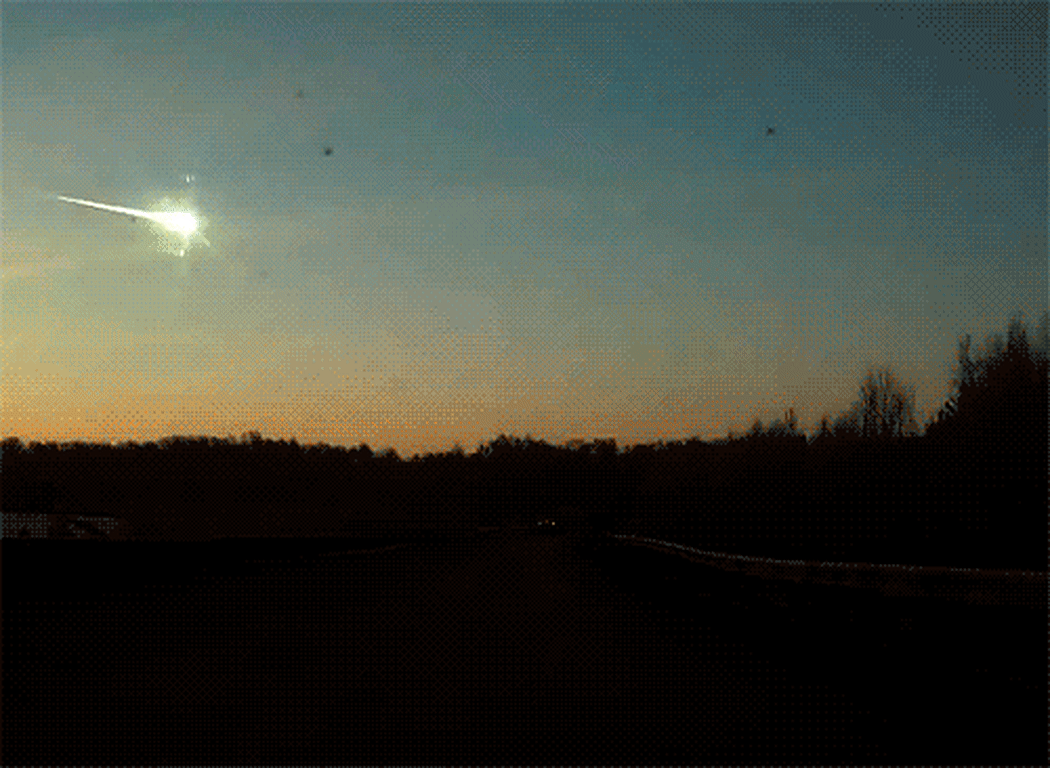Sixty-five million years ago, the evidence suggests, an asteroid 10 km across smashed into the Earth, wiping out the dinosaurs. With no space programme to save them, dinosaurs went extinct allowing an upright mammal with opposable thumbs to eventually take over the planet. Unlike the dinosaurs, humans have a sophisticated space programme. And Bruce Willis. But will that be enough to save us from the impact of some space rock?
There are heaps of rocks whizzing around our solar system. Lots of them could hit the earth. Big rocks. Small rocks. Asteroids. Meteors. Comets. Most of them, luckily, are locked in orbit around the sun between Mars and Jupiter. But some do sneak out.

Photo: Earth and Sky, Mt John University Observatory
In May an asteroid the size of small truck came within an astronomical hair’s breadth – 300,000 km – of hitting us. The close shave came “just days” after the asteroid’s discovery.
Alan Gilmore, the Resident Superintendent of University of Canterbury’s Mt John Observatory, based at Lake Tekapo says any asteroid that does sneak out and passes the orbit of Mars could hit Earth.
“Objects that cross the orbit of Mars are called Near-Earth Objects (NEOs). NEOs include some comets. They range in size from several kilometres across down to metres across,” Gilmore says. “There are about 1200 NEOs that are 1 km across, or bigger.”
But the big ones aren’t necessarily the ones we’ve got to be worried about. Of those 1200, only 154 are classified as Potentially Hazardous Asteroids (PHAs – which Gilmore notes can also be read as Perfectly Harmless Asteroids). There are a total of 1493 PHAs which come within 20 times the Moon’s distance from earth.
Dr Philip Sharp, a senior lecturer in Mathematics at the University of Auckland, is on the lookout for PHAs. He describes his work calculating asteroid orbits in a typically Kiwi fashion: with a cricket analogy.
“Imagine you are sitting in the stands at a cricket test and the ball is thrown in from deep long-off [the other end of the field from the batsman]. If you glimpse the ball for just a fraction of a second it is impossible to decide precisely how close the ball will get to the stumps.
“Something similar happens with newly discovered ‘potential impactors’,” Dr Sharp says. “We observe its motion for a few days and work out a tentative orbit from those observations.”
This orbit will be imprecise, but gives a clue as to the likelihood of an asteroid hitting Earth. Using computer models, Dr Sharp generates millions of simulations with orbits similar to the observation to see how many will hit Earth.

Jess Dallas praises our atmosphere as our most important line of defence . Photo: Supplied
On a cosmic scale, Earth is pretty small, and New Zealand is even smaller. So it would seem that the odds of us being hit are pretty small. But Jess Dallas, a New Zealander working as research scientist for Centre for Star and Planet Formation in Copenhagen, says meteorites land all over the world and New Zealand is no exception. They are usually small and don’t cause any damage, though.
“Large asteroid impacts in the past have affected the entire world, and have left their fingerprints in New Zealand,” she says.
“For example there is evidence in New Zealand's geologic record of the meteorite that caused the extinction of dinosaurs...As far as direct impacts in New Zealand go, there is at least one large impact crater in New Zealand called Mahuika crater, which is around 20 km wide and 153 m deep on the continental shelf near Snares Island.”
Alan Gilmore points to evidence of a 4km-wide asteroid plunging into the Pacific about 2.5 million years ago that sent waves over 60 metres high across New Zealand. But he agrees with Jess Dallas that most of our recent encounters have been smaller.
“Around 15 years ago a meteor the size of a car crossed the middle of the North Island making a sonic boom that frightened a lot of people. More recently a meteor produced a shock wave that shook up Christchurch.”
Because meteors generally tend to be softer rock they break and burn up – a lot like Bart’s Comet – when they plunge through our atmosphere. A few years back a rock the size of a brick – twice the size of the one in The Simpsons – crashed through the roof of a house in Auckland.
But if something bigger did hit New Zealand, it would be pretty catastrophic. Dr Sharp says if the 300 metre diameter asteroid Apophis, due to fly by earth in 2029, were to hit us would result in a three to six kilometre wide crater.
“Most people within 15 to 30 kms of the impact point will be killed. There will be earthquakes, fires, acid rain, and the sun will be dimmed by the dust in the atmosphere. Tsunamis will definitely occur if the impact is in the ocean.”
Dallas says size matters when it comes to impacts. Probably the world’s best preserved crater in Arizona was caused by a rock about 60 metres in diameter.
“To give an idea of the energy involved, the Chelyabinsk meteor that came down over Russia last year was probably only around 20 metres in diameter, and that released about 20 to 30 times as much energy as the atomic bomb in Hiroshima.”
Now for some bad news: Civil Defence does not have a contingency plan for asteroid impact and are honest about their capabilities and encourage us to be ready for emergencies in general.
@_jjw_ Unfortunately there is not much we can do in advance to prepare for such an event.
— MCDEM (@NZcivildefence) July 22, 2014
Despite landing an unmanned craft on a comet last week, Gilmore says that if being prepared means having something on the launch pad ready to go, we’re not.
“But then we couldn't deal with a short-term threat anyway, given uncertainties in the orbit.
“Had Apophis been found to be in an orbit that was a real threat in 2029 then already there would have been international efforts to study the object and to tweak its orbit so it misses us.”
He also says that most of the technologies being discussed use gentle long-term nudges to slowly change a PHA's orbit. “Near-Earth Objects are mostly ‘rubble piles’ of loosely-held boulders, pebbles and sand. Only the smallest are single solid rocks. So setting off an explosion nearby would turn the object into a cloud of rocks much more likely to hit us.”

The Chelyabinsk meteor entered Earth's atmosphere over Russia on 15 February 2013 Photo: Unknown
Which leads to an interesting question: which asteroid-related film is the most realistic? All three asteroid aficionados interviewed for this story prefer Deep Impact over Armageddon.
“Armageddon is totally unrealistic. Deep Impact is a lot more realistic because the attempted deflection of the asteroid is much further in advance of the impact than in Armageddon,” says Dr Sharp.
All three also agree that we shouldn’t lose sleep over entrusting the fate of the earth to a bunch of rapscallion oil drillers in a space shuttle, citing the low probability of impact and lack of anything we could do about it anyway.
Jess Dallas praises our atmosphere as our most important line of defence while Mr Gilmore says the impact of other things on our planet is much more worrying.
“The current risks from climate change, environmental degradation, overpopulation in some places, anti-science fundamentalism, the NEO threat is well down my list of worries for the future of civilisation.”
Dr Sharp sums up the impact the threat of impact easily, saying, “there is no need to stop going to the beach.”
This content is brought to you with funding support from New Zealand On Air.

